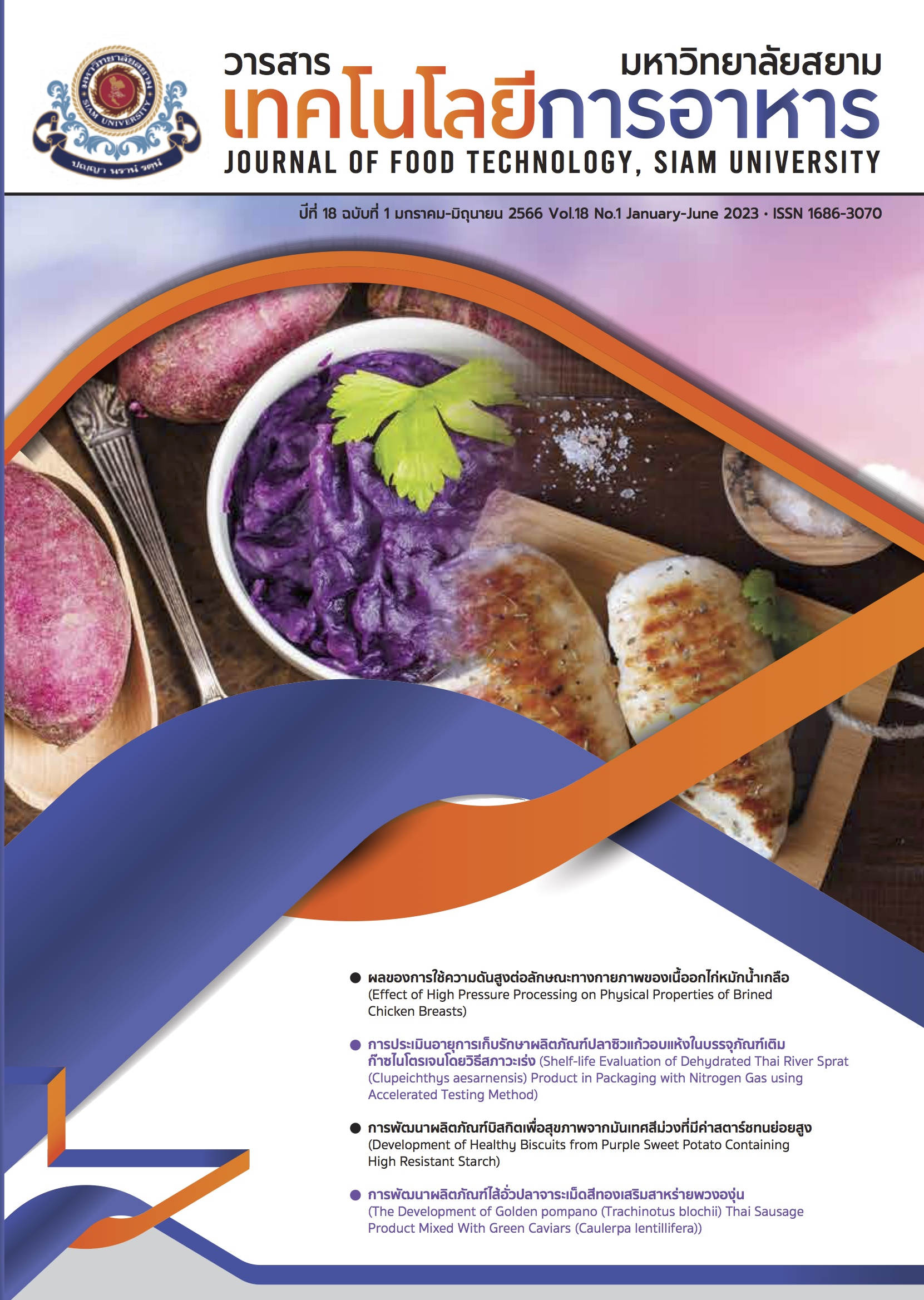ผลของการใช้ความดันสูงต่อลักษณะทางกายภาพของเนื้ออกไก่หมักน้ำเกลือ
Main Article Content
บทคัดย่อ
เทคโนโลยีความดันสูงมีส่วนช่วยเพิ่มความนุ่มให้เนื้อสัตว์ ความดันที่ระดับ 100 200 300 เมกะปาสคาล เวลา 10 นาที ถูกนำมาใช้เพื่อศึกษาเนื้ออกไก่หมักน้ำเกลือที่ความเข้มข้นร้อยละ 10 และ 20 (เนื้ออกไก่หมักพร้อมปรุง) จากนั้นให้ความร้อนที่ระดับพาสเจอร์ไรส์ 90±2 องศาเซลเซียส นาน 20 นาที (เนื้ออกไก่หมักพร้อมรับประทาน) ผลที่ได้พบว่าเนื้ออกไก่หมักพร้อมปรุงผ่านความดันที่ 200 เมกะปาสคาล ช่วยให้เนื้ออกไก่หมักน้ำเกลือที่ความเข้มข้นร้อยละ 10 มีเนื้อสัมผัสที่แข็งแต่ยืดหยุ่นมากกว่าที่ความเข้มข้นร้อยละ 20 อย่างมีนัยสำคัญทางสถิติ (p≤0.05) และเมื่อความดันเพิ่มขึ้นที่ระดับ 300 เมกะปาสคาล พบว่าเนื้ออกไก่หมักน้ำเกลือที่ความเข้มข้นร้อยละ 10 มีค่าแรงต้านต่อการเคี้ยวมากกว่าเนื้ออกไก่หมักที่ความเข้มข้นร้อยละ 20 อย่างมีนัยสำคัญทางสถิติ (p≤0.05) ค่าความสว่าง (L*) ของเนื้ออกไก่หมักน้ำเกลือพร้อมปรุงที่ความเข้มข้นร้อยละ 10 และ 20 มีค่าเพิ่มขึ้นอย่างมีนัยสำคัญทางสถิติ (p≤0.05) เมื่อความดันสูงขึ้นที่ 300 เมกะปาสคาล สำหรับความดัน 200 และ 300 เมกะปาสคาล มีผลต่อค่าความเป็นสีแดง (a*) ของเนื้ออกไก่หมักน้ำเกลือพร้อมรับประทานที่ความเข้มข้นร้อยละ 10 และ 20 (p≤0.05) ค่า ความเป็นกรด-ด่าง ของเนื้ออกไก่หมักน้ำเกลือพร้อมปรุงที่ความเข้มข้นร้อยละ 10 และ 20 มีค่าเพิ่มขึ้นอย่างมีนัยสำคัญทางสถิติ (p≤0.05) เมื่อให้ความดัน 300 เมกะปาสคาล
Article Details

This work is licensed under a Creative Commons Attribution-NonCommercial-NoDerivatives 4.0 International License.
บทความทุกบทความในวารสารเทคโนโลยีการอาหาร ทั้งในรูปแบบสิ่งพิมพ์ และในระบบออนไลน์ ถือเป็นลิขสิทธิ์ของมหาวิทยาลัยสยาม และได้รับการคุ้มครองตามกฎหมาย
References
Temgire, S., Borah, A., Kumthekar, S. and Idate, A. (2021). Recent trends in ready to eat/cook food products: A review. The Pharma Innovation Journal. 10(5): 211-217.
O'Neill, C., Cruz-Romero, M.C., Geraldine, D. and Kerry, J.P. (2019). Comparative effect of different cooking methods on the physicochemical and sensory characteristics of high pressure processed marinated pork chops. Innovative Food Science and Emerging Technologies. 54(8): 19-27.
Cavitt, L. C., Meullenet, J. F. C., Xiong, R. and Owens, C. M. (2005). The relationship of razor blade shear, allo-kramer shear, warner-bratzler shear and sensory tests to changes in tenderness of broiler breast fillets. Journal of Muscle Food. 16(3): 223-242.
Ashie, I. N. A., Sorensen, T. L. and Nielsen, P. M. (2002). Effects of papain and a microbial enzyme on meat proteins and beef tenderness. Journal of Food Science. 67(6): 2138-2142.
Kim, H-Y., Kim, K-J., Lee, J-W., Kim, G-W., Choe, J-H., Kim, H-W., Yoon, Y. and Kim, C-J. (2015). Quality characteristics of marinated chicken breast as influenced by the methods of mechanical processing. Korean Journal for Food Science of Animal Resources. 35(1): 101-107.
Xiong, Y.L. (2005). Role of myofibrillar proteins in water-binding in brine-enhanced meats. Food Research International. 38(3): 281-287.
Bowker, B.C., Callahan, J.A. and Solomon, M.B. (2010). Effects of hydrodynamic pressure processing on the marination and meat quality of turkey breasts. Poultry Science. 89(8): 1744-1749.
Bharti, S.K., Anita, B., Das, S. K. and Biswas, S. (2011). Effect of vacuum tumbling time on physico-chemical, microbiological and sensory properties of chicken tikka. Journal of Stored Products and Postharvest Research. 2(7): 139-147.
Huang, H-W., Hsu, C-P. and Wang, C-Y. (2020). Healthy expectations of high hydrostatic pressure treatment in food processing industry. Journal of Food and Drug Analysis. 28(1): 1-13.
Dong, K., Luo, X., Liu, L., An, F., Tang, D., Fu, L., Teng, H., and Qun, H. (2021). Effect of high pressure treatment on the quality of prepared chicken breast. International Journal of Food Science & Technology. 56(4): 1597-1607.
Yaldagard, M., Mortazavi, S.S. and Tabatabaie, F. (2008). The principles of ultra high pressure technology and its application in food processing/preservation: A review of microbiological and quality aspects. African Journal of Biotechnology. 7(16): 2739-2767.
Radovčić, N. M., Ježek, D., Markov, K., Frece, J., Curic, D. and Medić, H. (2020). The effect of high pressure treatment on the quality of chicken breast meat. Croatian Journal of Food Technology, Biotechnology and Nutrition. 14(3-4): 76-81.
Guo, T., Xue, S., Zou, Y., Han, M., Xu, X. and Zhou, G. (2015). Effect of sodium chloride on the properties of ready-to-eat pressure-induced gel-type chicken meat products. Journal of Food Process Engineering. 40(1): 1-11.
Ramirez-Suarez, J. C. and Morrissey, M. T. (2006). Effect of high pressure processing (HPP) on shelf life of albacore tuna (Thunnus alalunga) minced muscle. Innovative Food Science & Emerging Technologies. 7(1): 19-27.
Kruk, Z. A., Yun, H., Rutley, D. L., Lee, E. J., Kim, Y. J. and Control, C. J. J. F. (2011). The effect of high pressure on microbial population, meat quality and sensory characteristics of chicken breast fillet. Food Control. 22(1): 6-12.
Carlez, A., Veciana-Nogues, T. and Cheftel, J.C. (1995). Changes in colour and myoglobin of minced beef meat due to high pressure processing. Lebensmittel-Wissenschaft & Technologie. 28(5): 528-538.
Bak, K. H., Bolumar, T., Karlsson, A. H., Lindahl, G. and Orlien, V. (2019). Effect of high pressure treatment on the color of fresh and processed meats: a review. Critical Reviews in Food Science and Nutrition. 59(2): 228-252.
Zhuang, H. and Browker, B. (2016). Effect of marination on lightness of broiler breast fillets varies with raw meat color attributes. LWT- Food Science and Technology. 69(7): 233-235.
Smith, D. P. and Young, L. L. (2007). Marination pressure and phosphate effects on broiler breast fillet yield, tenderness, and color. Poultry Science. 86(12): 2666-2670.
Sazonova, S., Galoburda, R. and Gramatina, I. (2017). Effect of high pressure processing on microbial load in pork. Research for Rural Development. 1: 238-243.
Utama, D.T, Lee, S.G, Baek, K. H, Chung, W. S, Chung, I. A, Jeon, J. T. and Lee, S. K. (2017). High pressure processing for dark-firm-dry beef: effect on physical properties and oxidative deterioration during refrigerated storage. Asian-Australasian Journal of Animal Sciences. 30(3): 424-431.

